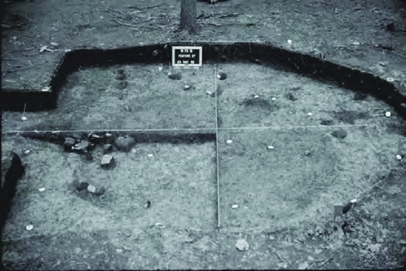
 In a 2010 paper (available here and here and here), Lynne Sullivan and Shannon Koerner describe a circular post structure at the DeArmond Site (40-Re-12), Roane County, Tennessee. WPA excavations at the site produced features, debris, and architectural remains, much of which was attributable to Mississippian occupations. Sullivan and Koerner argue that the single circular structure from the site (Feature 30) predates the Mississippian occupation and is Late Woodland in age. As shown in the illustration to the right (from Sullivan and Koerner 2010:39), the structure was of single post construction and measured approximately 8.2 m in diameter. The structure will be added to the database as Structure 2255. I thank Dr. Sullivan for bringing the paper to my attention.
1 Comment
 A 2004 paper by Dennis Curry and Maureen Kavanagh (available online here) describes excavations at the Rosenstock Village site (18-Fr-18) in Frederick County, Maryland. The main deposits at the site are associated with the Late Woodland Montgomery Complex, dating to the fourteenth century AD. Again I thank Dr. Dennis Curry for bringing the site and report to my attention. Two "keyhole" structures (Features 2 and 27) were identifed. Feature 27 is shown in the illustration to the right (from Curry and Kavanagh 2004:14, Figure 19). At the Rosenstock site, these small (< 5 square meters) elliptical, semi-subterranean structures were interpreted as the probable remains of sweat lodges. While similar structures have been interpreted as sweat lodges at other sites, there has been some debate about whether "keyhole" structures may be the remains of houses or storage features (see MacDonald 2008; Smith 1976). The two structures from Rosenstock will be added to the database as Structures 2253 and 2254.  Excavations in 2002 and 2003 exposed two domestic post structures at the Winslow Site (18-Mo-9) in Montgomery County, Maryland. These structures are described in a 2005 report by Richard Dent in Maryland Archaeology. I thank Dr. Dennis Curry for making me aware of the structures and sending me a copy of the paper. The outlines of both structures can be seen in the illustration to the right (Figure 5 from Dent 2005:11). Various features and segments of a palisade were also exposed. The structures were attributed to the Montgomery Complex and believed to date to the mid-fourteenth century AD. They will be added to the database as Structures 2251 and 2252.  Martin Gallivan's (1999) dissertation describes a block excavation at the Little River site (44-Go-30b) in that exposed portions of two Late Woodland structures (figure to right from Gallivan 1999:221). One of the structures appeared to an elliptical post structure. The pit feature inside the structure (Feature 1) was radiocarbon dated to around AD 1200-1300 (Gallivan 1999:220). Goochland County, Virginia, lays claim to, among other things, the early schooling of Thomas Jefferson. The historical society has a nice collection of photographs by W. Edwin Booth. I am more than a little jealous that their drive-in theater opens this weekend: that's a sign of Spring that certainly trumps the four north-going geese I saw this morning. And if that wasn't enough, there is a Rock & Roll Jubilee Show this evening at the high school. No wonder Justin Verlander lives there.  Martin Gallivan's (1999) dissertation includes information on several Woodland and Late Prehistoric sites in Virginia with structural remains (see also his later paper in American Antiquity). The figure to the right (from Gallivan 1999:197) shows the distribution of postmolds and features exposed in excavations at the Wood site (44-Ne-143), Nelson County. Gallivan used multiple approaches to analyze the distribution of posts, identifying the outlines of five elliptical structures (Structures A, B, C, D, and E) of varying size. Radiocarbon dates from features at the site suggest the structures were constructed around AD 1000-1050. The Wood site structures will be Structures 2237-2241 in the database.
The Reid and Rajnovich (1991) paper contains pointers to publications with data on several Woodland and Archaic structures in the region. I've never been there, but based on its entry in Large Canadian Roadside Attractions it looks like a nice place to visit.
|
AuthorAndrew A. White Archives
January 2016
Categories
All
|





 RSS Feed
RSS Feed
